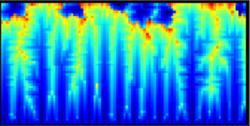Lab-0011
Quantifying river channel evolution with Landlab
Contributor(s)

In this exercise you will modify the code to get a better understanding of how rock uplift rates and patterns and the erodibility coefficient control fluvial channel form.
Landlab is an element of the CSDMS Workbench, an integrated system of software tools, technologies, and standards for building and coupling models. Learn more at https://csdms.colorado.edu/wiki/Workbench.
Classroom organization
Answer these questions before running the notebook.
1. What do you think will happen to total relief (defined as the maximum minus the minimum elevation, here area is fixed) and channel slope at steady state if $K_{sp}$ is uniformly increased?
2. What do you think will happen to total relief and channel slope at steady state if $U$ is uniformly increased?
3. How do you think a steady-state landscape with a uniform low rock uplift rate will respond if rock uplift is uniformly increased (relative to a steady base level)? How will channel slopes change through time?Skills
Lab notes
Start at the top by reading each block of text and sequentially running each code block (shift - enter OR got to the Cell pulldown menu at the top and choose Run Cells).
If you just change one code block and rerun only that code block, only the parts of the code in that code block will be updated. (E.g. if you change parameters but don't reset the code blocks that initialize run time or topography, then these values will not be reset.)
This lab can be run on the explore (for educators) and jupyter (for general use) instances of EarthscapeHub: just click one of the links under the Run online using heading at the top of this page, then run the notebook in the "CSDMS" kernel.
If you don't already have an EarthscapeHub account, follow the instructions to sign up at https://csdms.colorado.edu/wiki/JupyterHub. If you're an educator, you can get EarthscapeHub accounts for you and your students--please contact us through the CSDMS Help Desk: https://csdms.github.io/help-desk.
Requirements
If run locally, this lab requires the installtion of the Python packages numpy, matplotlib, and landlab. For more information on installing Landlab, see https://landlab.github.io/#/#install.
References
- Hobley, D. E. J., Adams, J. M., Nudurupati, S. S., Hutton, E. W. H., Gasparini, N. M., Istanbulluoglu, E., and Tucker, G. E.: Creative computing with Landlab: an open-source toolkit for building, coupling, and exploring two-dimensional numerical models of Earth-surface dynamics, Earth Surf. Dynam., 5, 21–46, https://doi.org/10.5194/esurf-5-21-2017, 2017.
- Barnhart, K. R., Hutton, E. W. H., Tucker, G. E., Gasparini, N. M., Istanbulluoglu, E., Hobley, D. E. J., Lyons, N. J., Mouchene, M., Nudurupati, S. S., Adams, J. M., and Bandaragoda, C.: Short communication: Landlab v2.0: a software package for Earth surface dynamics, Earth Surf. Dynam., 8, 379–397, https://doi.org/10.5194/esurf-8-379-2020, 2020.
